Find more information in the General Comments section of the assessment
Find more information in the Rating Validity tab of the assessment
- See More
- See More
- See More
- See More
- Good
- Adequate
- Marginal
- Weak
- Poor
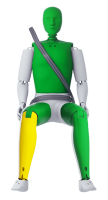 Passenger
Passenger
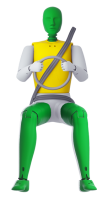 Driver
Driver
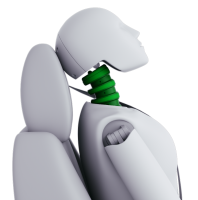 Front Seat
Front Seat
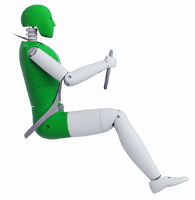 Car
Car
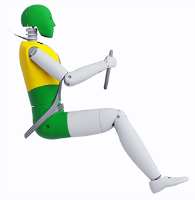 Pole
Pole
- Good
- Adequate
- Marginal
- Weak
- Poor
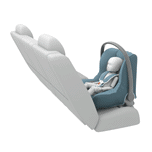

Passenger
outboard
center
Fitted to the vehicle as standard
Not fitted to the test vehicle but available as option
Not Available
Both dummies were properly contained by their rearward facing child restraints in the front and side impacts, minimising the risk of contact with parts of the car interior. Although the passenger airbag can be disabled with an optionally fitted switch to allow a rearward-facing child restraint to be used in that seating position, insufficient information is provided to the driver regarding the status of the airbag preventing any reward for the system. Permanently attached labels on the sun visor clearly warn of the dangers of using a rearward facing child seat in that position without first disabling the airbag.
- Good
- Adequate
- Marginal
- Weak
- Poor
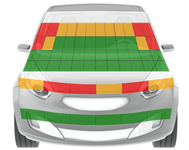
Head Impact 19.6 Pts
Pelvis Impact 1.0 Pts
Leg Impact 6.0 Pts
Good protection was provided by the bumper to pedestrians' legs and the car scored maximum points in this and the area likely to be struck by a child/small adult. In those areas likely to be struck by an adult's head the protection offered by the bonnet was predominantly marginal and poor, as was the bonnet leading edge where a pedestrians upper leg would impact.
- Good
- Adequate
- Marginal
- Weak
- Poor
| System Name | ESP | |
| Performance | ||
| Vehicle Yaw Rate @ COS + 1.00 s | 2.1% | meets ECE requirements |
| Vehicle Yaw Rate @ COS + 1.75 s | 2.4% | meets ECE requirements |
| Lateral Displacement @ BOS + 1.07 s | 3.34 m | meets ECE requirements |
| Applies To | All seats | ||
| Warning | Driver Seat | Front Passenger(s) | Rear Passenger(s) |
| Visual | |||
| Audible | |||
|
|||
Electronic stability control is standard equipment and met Euro NCAP's test requirements. A seatbelt reminder system is standard equipment for the front and rear seats. A speed limitation device is not currently available on the Audi A3.
- Specifications
- Safety Equipment
- Videos
- Advanced Rewards
- Rating Validity
Specifications
Tested Model Audi A3 1.4 'Attraction', LHD
Body Type - 3 door hatchback
Year Of Publication 2012
Kerb Weight 1235kg
VIN From Which Rating Applies - applies to all A3s of the specification tested
Class Small Family Car
Safety Equipment
Note: Other equipment may be available on the vehicle but was not considered in the test year.
Fitted to the vehicle as standard
Fitted to the vehicle as option
Not fitted to the test vehicle but available as option
Not Available
Not Applicable
Videos
Advanced Rewards
Rating Validity






Find more information in the General Comments section of the assessment
From crash data presented by Audi, Euro NCAP is satisfied that a similar level of protection is offered by the Audi A3 Sportback and the Audi A3 Limousine.
 Share
Share
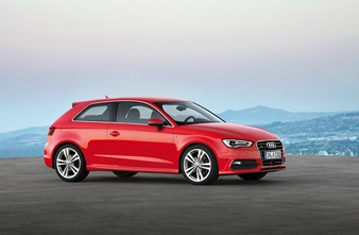




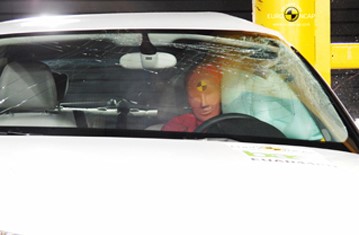
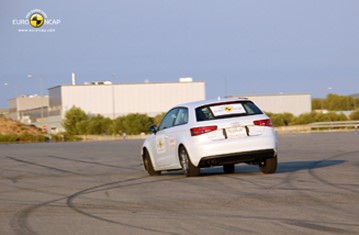




The passenger compartment remained stable in the frontal impact. Dummy readings indicated good protection of the knees and femurs of the front seat occupants. Audi showed that a similar level of protection would be available to occupants of different sizes and to those sat in different positions. Maximum points were scored in the side barrier test. In the more severe side pole impact, protection of the driver's chest was rated as adequate. The front seats and head restraints provided good protection against whiplash injury in the event of a rear-end collision.